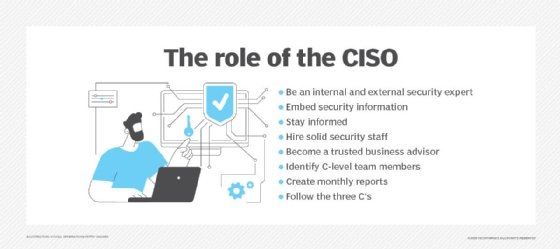
James Thew - Fotolia
Portrait of a CISO: Roles and responsibilities
Success in the role of CISO requires security experts to wear many hats. Couple that with changes in compliance regulations and sophisticated cyberthreats, and CISOs are left with a full plate.
The chief information security officer role was created in recognition of increasing and evolving threats to enterprise data and information security.
This executive manager is in charge of operations, strategy and budget for the organization's security infrastructure and assets. CISOs serve as advisors to the board of directors on security issues, threats and regulatory compliance measures. In addition to advising other executives, a CISO reports to customers and shareholders as well. Employees within an organization look to the CISO for security awareness training and assurance that their leadership focuses on improving security posture.
CISOs must be vigilant day in and day out when it comes to predicting and outmaneuvering attacks. This is what makes the CISO different from other security responders. Rather than waiting for attacks to happen to execute incident response plans, this executive functions to anticipate those attacks. For this reason, a CISO is never done learning about threats and vulnerabilities. The research never stops because the evolving threats never do.
Here are three informative articles to shed light on the importance of the CISO role, the regulatory guidelines CISOs enforce and the skills necessary to be successful in the position.
Evolution of threats expands CISO roles and responsibilities
The tech industry has recently experienced executive-level reorganization. CISO roles and responsibilities are now simultaneously shifting and expanding in response to job title revisions, not to mention increasingly sophisticated security threats.
In the past, the role of CISO has been described as largely advisory. Originally, this person was expected to update company leadership on security incidents and conduct security awareness training for employees. Fast forward to today's challenging threat landscape, coupled with the advent of a cybersecurity skills shortage, and CISOs will tell you the job hasn't gotten any easier. Read more on the evolution of this security manager's position and how this important employee may finally be getting the recognition she deserves.

New regulation policies affect CISO compliance oversight
A CISO must be vigilant about compliance with government and industry regulations. Familiarity with policies and guidelines, like GDPR and the California Consumer Privacy Act, is a must. CISOs organize security assessments and audits to determine weak spots before cyberattacks happen and, if deemed necessary, identify how to improve cybersecurity awareness within the organization. This is complicated by the fact that new legislation constantly introduced by lawmakers around the world launch cybersecurity concerns into the center of debate. Read more about how this is changing the daily grind for CISOs worldwide.
CISOs must demonstrate quality communication skills
The CISO must be a good communicator. One of the most important of the CISO's roles and responsibilities is communication with customers and shareholders alike, who need assurance that their leadership approach prioritizes the security posture of the organization. CISOs work with other departments within the organization to reduce operational risks in the event of a security incident. A CISO must relay highly technical language to employees and leaders within his organization who may not possess the same technical background. The ability to present information on security compliance and company policy in accessible terms to co-workers is essential.
It is also vital that the lines of communication always be open between the CISO and the board of administrators. Fortunately, the role of CISO is experiencing increased recognition and interest from company executives who accept that security is of the utmost importance to businesses and customers alike. Read more from seasoned CISOs about how to pitch important messages succinctly and effectively to an administrative audience.








